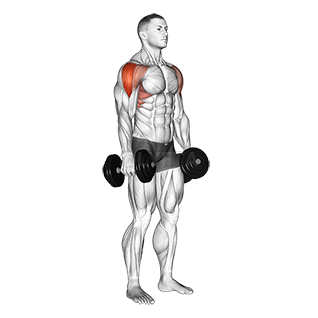
Dumbbell Seated Bent Arm Lateral raise
Exercise Profile
Related Exercises:
Introduction to the Dumbbell Seated Bent Arm Lateral raise
The Dumbbell Seated Bent Arm Lateral Raise is a strength-building exercise that primarily targets the deltoids, enhancing shoulder definition and improving upper body strength. This exercise is suitable for individuals at all fitness levels, from beginners to advanced athletes, as it can be easily adjusted based on the weight of the dumbbells used. People would want to incorporate this exercise into their routine to improve their shoulder mobility, enhance their physical appearance, and support functional movements in daily activities.
Performing the: A Step-by-Step Tutorial Dumbbell Seated Bent Arm Lateral raise
- Bend your elbows at a 90-degree angle, so the dumbbells are parallel to the floor.
- Keeping your back straight and your elbows slightly bent, lift the weights out to the sides until they are at shoulder level.
- Pause for a moment at the top of the movement to ensure maximum muscle contraction.
- Slowly lower the dumbbells back to the starting position, maintaining control of the weights throughout the movement.
Tips for Performing Dumbbell Seated Bent Arm Lateral raise
- Appropriate Weight: Choose a weight that is challenging but manageable. It's a common mistake to use too heavy dumbbells which can lead to incorrect form and potential injuries. It's better to start with a lighter weight and gradually increase as your strength improves.
- Controlled Movement: Avoid the mistake of performing the exercise too quickly. The movement should be slow and controlled, both when you raise and lower the dumbbells. This ensures that your muscles are fully engaged throughout the exercise, making it more effective.
- Range of Motion: Lift the dumbbells to shoulder height, keeping your elbows slightly bent. Avoid lifting the weights too high or locking your elbows as this can put unnecessary strain on your shoulder joints
Dumbbell Seated Bent Arm Lateral raise FAQs
Can beginners do the Dumbbell Seated Bent Arm Lateral raise?
Yes, beginners can definitely do the Dumbbell Seated Bent Arm Lateral Raise exercise. However, it's important to start with a weight that is manageable and doesn't strain the muscles excessively. Proper form is crucial in this exercise to avoid injury, so beginners might benefit from supervision or guidance from a trainer. As with any new exercise, it should be incorporated gradually into a workout routine.
What are common variations of the Dumbbell Seated Bent Arm Lateral raise?
- Dumbbell Seated Straight Arm Lateral Raise: In this variation, you perform the exercise with your arms straight, which places more emphasis on the deltoid muscles.
- Dumbbell Incline Bench Lateral Raise: This variation is performed on an incline bench, which changes the angle of the exercise and targets different parts of the shoulder muscles.
- Dumbbell Lying Side Lateral Raise: In this variation, you lie on your side on a flat bench and perform the lateral raise, which can help isolate the shoulder muscles more effectively.
- Dumbbell Bent Over Lateral Raise: This variation is performed bending over, which targets the rear deltoids and upper back muscles.
What are good complementing exercises for the Dumbbell Seated Bent Arm Lateral raise?
- Bent-Over Dumbbell Rows: This exercise focuses on the back muscles, especially the latissimus dorsi, which act as stabilizers during the Dumbbell Seated Bent Arm Lateral Raise, therefore improving the balance and control during the execution of the latter.
- Dumbbell Front Raises: This exercise directly targets the anterior deltoids, complementing the Dumbbell Seated Bent Arm Lateral Raise by ensuring all parts of the deltoids are evenly worked, promoting balanced muscle development and preventing potential injury.
Related keywords for Dumbbell Seated Bent Arm Lateral raise
- Dumbbell shoulder exercise
- Seated Bent Arm Lateral raise
- Dumbbell workout for shoulders
- Shoulder strengthening exercises
- Dumbbell Lateral raise seated
- Bent Arm shoulder workout
- Dumbbell exercises for upper body
- Seated shoulder workout with Dumbbell
- Arm Lateral raise with Dumbbell
- Shoulder toning exercises with Dumbbell.









